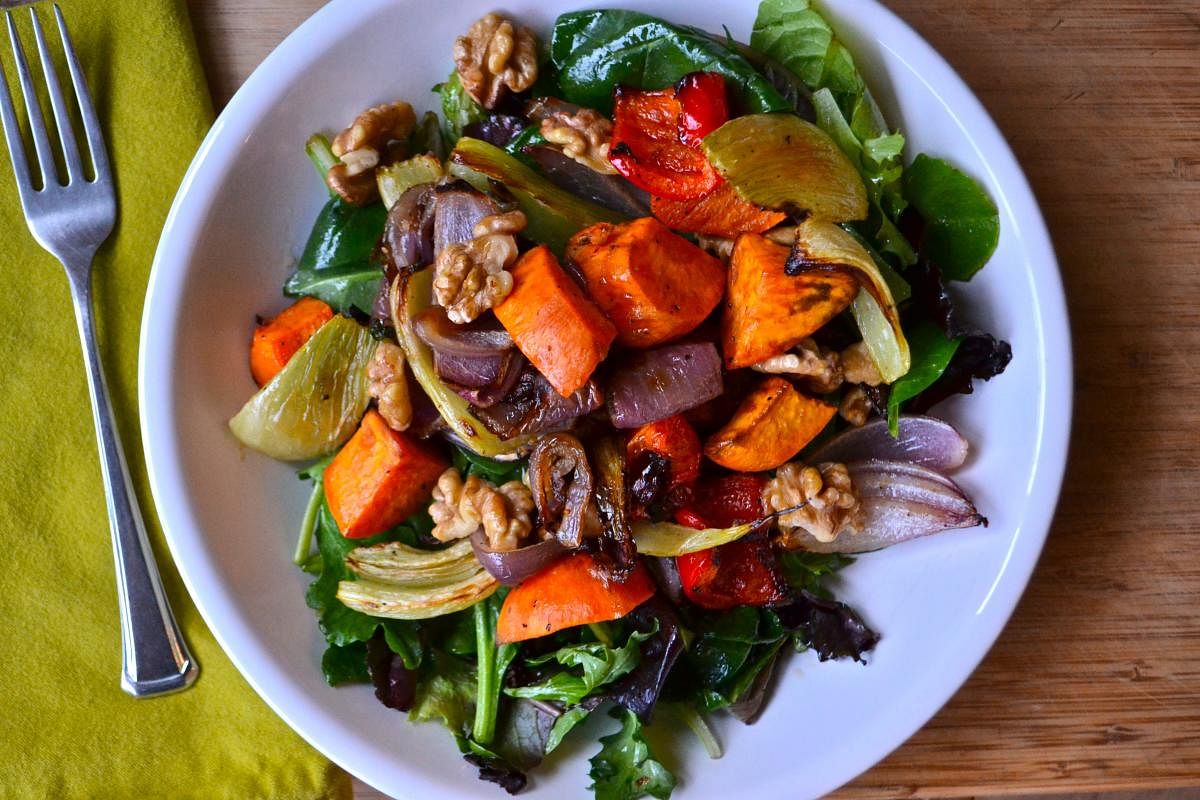

The glorious winter sunshine may slowly be giving way to the brighter, harsher summer sun. But thankfully, the freshest winter vegetables are still around for everybody to savour. Step out to your nearest market and you are sure to spot leafy greens at their best besides carrots, beets, sweet potatoes and berries of all colours. So be it strawberries or green chana, oranges or namma very own avarekalu, it’s time to warm your body up to these delicious treats and also avail the health benefits that come along with them.
Gauravi Vinay, a nutritionist and food consultant, always advises her clients to eat seasonal and local. So at the moment, leafy greens, sweet potatoes, berries and citrus fruits form an inevitable part of her clients’ diets. “Seasonal and local produce is fresher, healthier and reaches us faster. When we eat seasonally, it means we are eating produce that isn’t sprayed with a lot of boosters or pesticides or travelling through various markets or going through a lot of processing,” she observes.
Winters spell mustard greens or sarson ka saag with makki ki roti and dollops of butter for many. “In the North during this season, greens like mustard, palak, bathua and methi are very popular. Black and red carrots are also really sought-after,” says Delhi-based Swasti Aggarwal, the food strategist of Food Hall India, a lifestyle food store. According to her, kanji, a probiotic fermented drink with carrots and beets, and raita with cooked bathua leaves are two of the easiest and most delicious ways to consume these seasonal goodies.
Of course, greens aren’t just limited to leafy greens but also the lovely, luscious peas and averakalus that are heaped up on carts and available at every nook and cranny this season. Rahul Sharma, head chef of Araku Coffee India, a gourmet coffee shop, cooks not just with peas but even their shells. “The best aromas and flavours of peas are in the shell. You can sense this in the fumes that come out every time you snap open a pea,” he informs. “We juice the shell and cook the peas in this liquid. Since the peas are also stored in this water and absorb all the flavours from it, they taste amazing.”
In addition to a dish with beets of varied colours, sunchoke roast and spätzle with purple and orange sweet potatoes, Rahul has also whipped up his take on the good old Cassata this season. “It is tri-coloured and made from beetroot, coconut and pandan leaf,” he says.
From farm to table
It’s also the season of fresh pulses and legumes like fresh ragi, toor dal and jowar. But if you, like the majority out there don’t own a farm, worry not! There are farms that do subscription boxes and throw in some fresh legumes from time to time. Says Sumeet Kaur, founder of Spudnik Farms, which works with farmers in Chikkaballapur and Uttara Karnataka and delivers local and seasonal produce, “We practise natural and regenerative farming and one of our key philosophies is to grow produce according to the season and local conditions.”
In addition to fresh legumes and avarekai, this is also the season of tuber crops like yam, taro and sweet potatoes, she notes. “Green garlic is also really popular among our customers.” Yam beans (also known as shakalu) and cruciferous vegetables like lettuce, broccoli and cauliflower are much sought-after too among Sumeet’s customers. “Although lettuce isn’t a local crop, the weather is conducive to grow it,” she explains.
While most vegetables and fruits are available throughout the year now, it’s best to eat them when they are in season. “My recommendation to people is to bring more diversity to their food. Give boiled peanuts and sweet potatoes a chance. Bake sweet potatoes and have them with chaat masala or mash them with peanuts and berries for a wholesome snack. In chutneys, replace lemon or tamarind with amla. Or even better, make amla salsa with onions, tomatoes, berries, olive oil and nuts and enjoy it with papads or sourdough breads. But ensure that the amla is fresh as cooking it kills the nutrients in it,” suggests Gauravi. In a nutshell, Rahul sums up, “Thanks to globalisation, we get almost all vegetables and fruits throughout the year. But personally, the more seasonality we follow, the healthier we are.”
So what are you waiting for? Go ahead. Treat yourself to that hearty bowl of gajar ka halwa while the season of red carrots is still on!
Green chickpeas masala puri
Ingredients
Boiled green chana/ green chickpeas: 2 cups
Boiled potatoes (small): 4
To grind without roasting
Onions: 2 medium
Ginger & garlic: 10 gms each
Coriander seeds: 2 tbsp
Red chilli powder: 1/2 tbsp
Garam masala: 1 teaspoon
Pepper: 20-25 whole peppercorns
A handful of coriander leaves
Green chillies: 6-7
For the masala
Tomatoes: 4
Bay leaves: 2
Roasted cumin powder: 1/2 tsp
Salt to taste
Turmeric: 1/2 teaspoon
Oil: 1.5 tablespoons
For assembly (as per taste)
Crushed puris
Green and tamarind-date chutneys
Chopped onions
Sev
Boiled and cubed potatoes
Method
In a wok, heat oil. Throw in a couple of bay leaves and finely chopped tomatoes. Add turmeric powder and cook till it’s mushy.
Add the ground masala paste and cook until the raw smell goes.
Now add the cooked green chana and roughly broken potatoes.
Season with salt and cook for eight to ten minutes adding water as needed to adjust to a ragda consistency.
Assembly
Place crushed ‘puris’ on a plate, pour the hara chana ragda on top, drizzle some green and tamarind-date chutneys.
Top with cooked cubed potatoes, raw chopped onions, coriander and sev.
You can even top it with papads and enjoy!
(Recipe & photos by food consultant Gauravi Vinay)